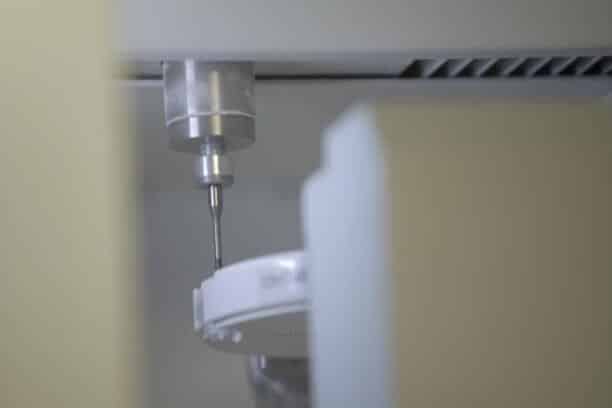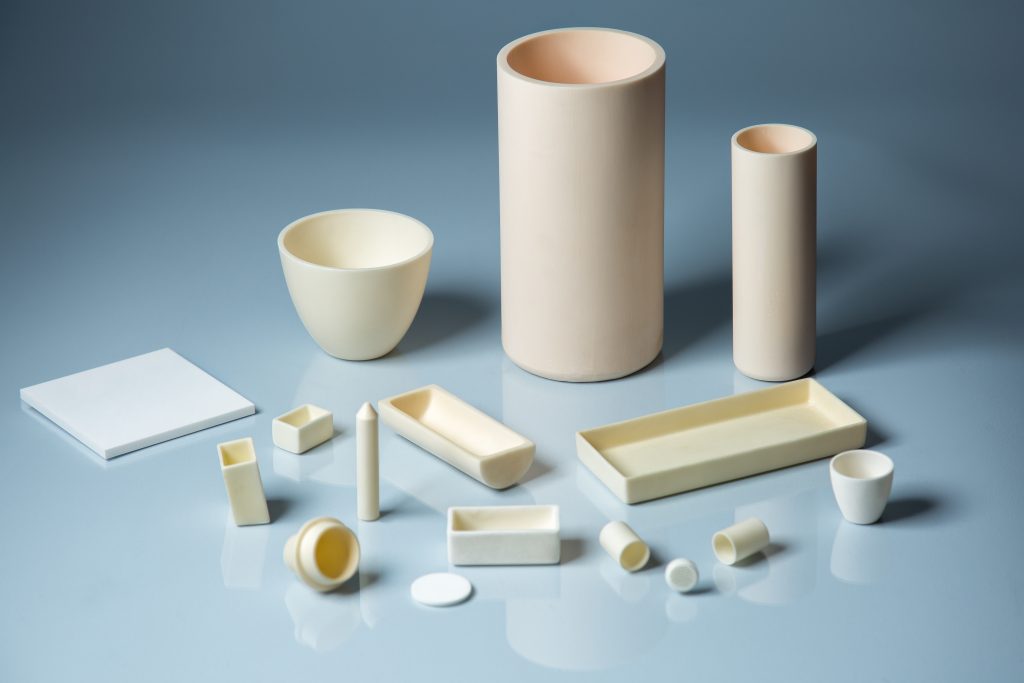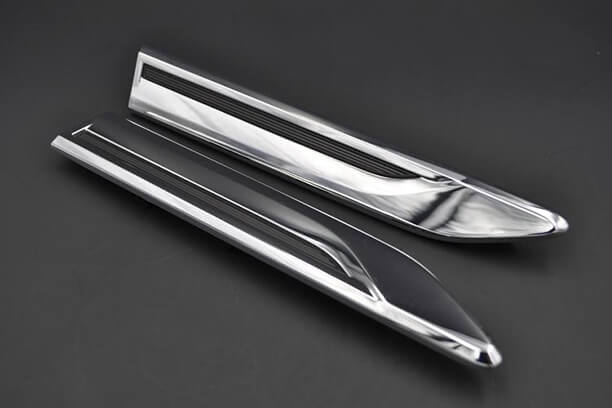CNC machining is a highly efficient technique for mass-producing ceramic items. This approach is versatile, enabling the creation of complex designs and parts with precise tolerances. It’s a method that can produce thousands of high-quality, smoothly finished parts quickly.
But what does CNC machining of ceramics involve? What distinctive characteristics do various ceramic materials possess? What considerations are important during the CNC machining of ceramics?
This guide will cover the diverse kinds of ceramics, their multiple uses, advantages and challenges of using ceramics in CNC machining, and provide guidelines for the design and machining of ceramic products.
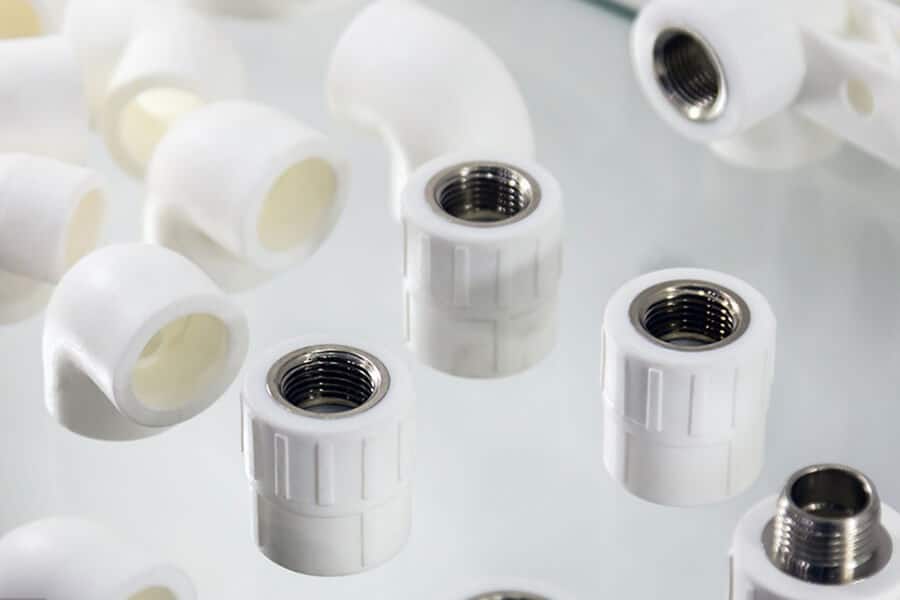
What is Ceramic CNC Machining?
Ceramic CNC machining is a process where ceramic materials are sculpted into various forms using computer-guided tools. This process incorporates techniques like milling, drilling, grinding, and turning. These methods are applied to ceramics that have reached their maximum density after firing.
Due to their hardness and brittleness, ceramics pose a challenge for conventional machining methods. However, using CNC machines to cut ceramics offers greater precision and control, enhancing the accuracy of cuts. This technology is particularly effective for producing components with intricate designs and strict tolerances, making it a suitable choice for numerous applications.
The procedure typically starts with the creation of a computer-aided design (CAD) model of the intended part or design. This model guides the generation of a toolpath that is then inputted into the CNC machine. Following this, the machine precisely cuts or molds the ceramic material as per the defined toolpath.
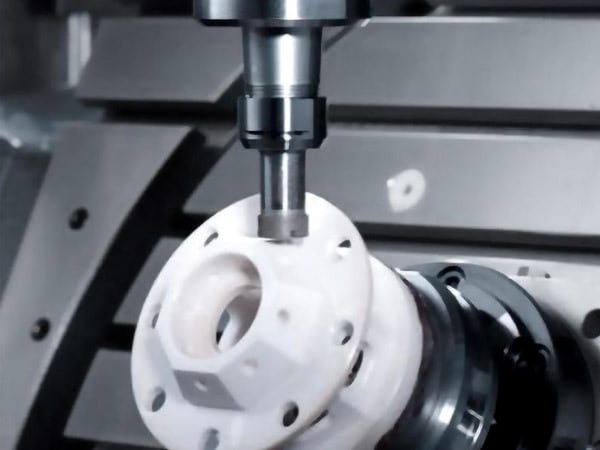
Suitable Ceramic Materials for CNC Machining
Various ceramic materials have distinct mechanical, physical, and chemical characteristics, which makes not all of them suitable for CNC machining. The following are the materials that are most compatible for use in CNC machining processes.
Alumina Ceramic
Alumina ceramic, or aluminum oxide, is a versatile and frequently used material known for its high hardness, durability, electrical insulation, and resistance to heat and corrosion. In CNC machining, it’s preferred for crafting precise components used in a variety of industries, including aerospace, automotive, electronics, and medical devices.
Its hardness and resistance to wear make it ideal for cutting tools, while its ability to withstand high temperatures and provide electrical insulation suits it for high-temperature and electrical applications.
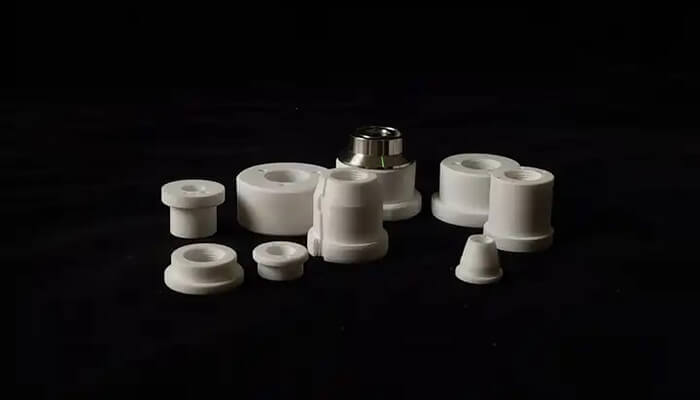
Aluminum Nitride
Aluminum nitride has a thermal expansion rate lower than alumina, aligning closely with that of silicon wafers. This feature, along with its capability to be metalized, makes it an excellent material choice for semiconductor applications.
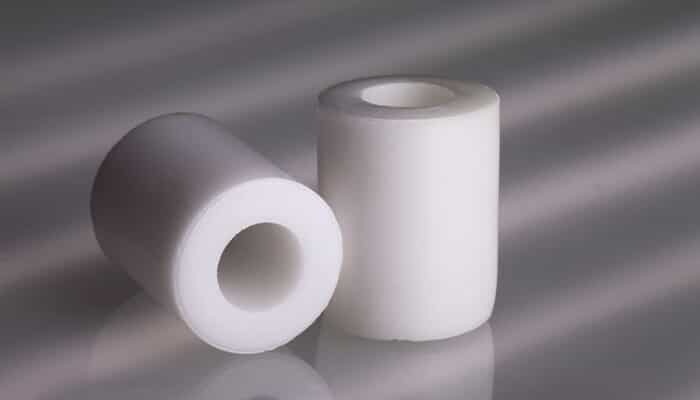
Boron Nitride
Boron Nitride, with the chemical formula BN, is a distinct type of ceramic made of boron and nitrogen. It’s characterized by its low dielectric constant, minimal thermal expansion, and low loss tangent. Additionally, it’s chemically inert, electrically resistant, and can withstand thermal shock.
This material is produced as a hot-pressed solid, forming a plate-like crystal structure in a hexagonal pattern. This structure allows for the precise machining of complex parts with close tolerances.
Moreover, Boron Nitride ceramic parts don’t need firing or heat treatment before use. These thermal characteristics make Boron Nitride suitable for various industries, particularly in semiconductor and electronics production.
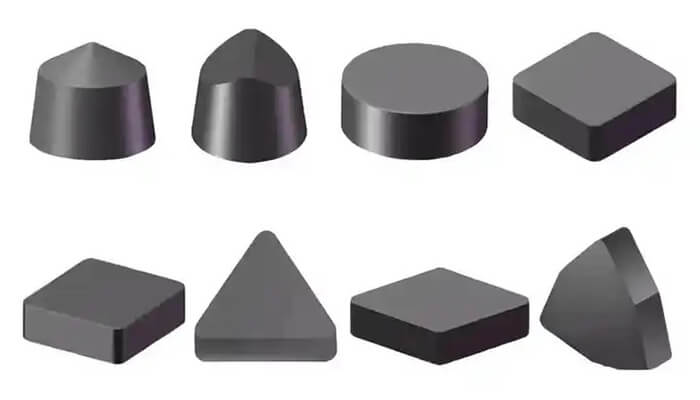
Silicon Carbide Ceramic
Silicon Carbide (SiC) ceramics represent an advanced class of technical ceramics known for their exceptional hardness, high thermal conductivity, and strong resistance to thermal shock and wear. These qualities make them widely applicable in various industrial settings.
CNC machining of SiC ceramics is increasingly favored for manufacturing cutting tools, wear-resistant parts, and structural components. Their extreme hardness enables efficient machining of tough materials like high-strength alloys, hardened steels, and superalloys. The high thermal conductivity of SiC aids in effective heat dispersion during machining, which minimizes tool wear while enhancing cutting speed and precision.
Furthermore, the outstanding thermal shock resistance and chemical stability of SiC ceramics make them ideal for challenging conditions, including corrosive and high temperatures environments.
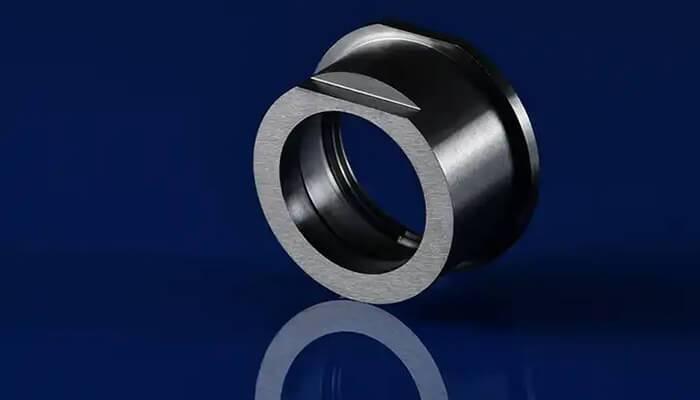
Zirconia Ceramic
Zirconia ceramic, or zirconium dioxide, is a high-end ceramic known for its outstanding strength, toughness, chemical and corrosion resistance, making it ideal for medical and dental applications. Its high hardness enables faster machining speeds. With superior thermal resistance and a higher melting point than alumina, zirconia excels in absorbing stress, making it perfect for structural ceramic parts.
Its exceptional mechanical strength at room temperature favors CNC machining as the best fabrication method. Zirconia is extensively used in various structural components like ball valves, fiber optic pins, and watch cases, and its excellent thermal properties make it suitable for functional parts like induction heating tubes and heating elements.
Steatite Ceramic
Steatite ceramic, commonly known as high-frequency ceramic and primarily composed of hydrous magnesium silicate, is a budget-friendly option in the realm of ceramics. It stands out for its excellent electrical resistance at high temperatures, low dielectric loss, low dissipation factor, and strong mechanical strength, making it well-suited for CNC machining due to its capacity to withstand significant stress before breaking.
The low-loss characteristic of steatite renders it ideal for creating insulators in broadcast antenna equipment, and its heat resistance combined with dielectric properties make it an excellent choice for producing durable, fire-rated terminal blocks.
Quartz Ceramic
Quartz ceramic, made primarily of pure silica (silicon dioxide), is notable for its excellent optical and chemical properties. It offers high tensile strength, thermal stability, and superb thermal insulation, which makes it a preferred choice in lighting and semiconductor industries.
Machining quartz ceramic requires strong diamond tools, water jetting, or grinding due to its high hardness. This material is especially fitting for creating precision parts that demand contamination control and temperature resistance, aligning well with CNC machining techniques.
Quartz ceramics are employed in various applications, including in rocketry for missile nose cones, engine nozzles, and antenna firings, as well as in space technology for connectors, pipes, valves, heat exchangers, furnace linings, and heat protection gear.
Cordierite Ceramic
Cordierite ceramic, composed of magnesium, aluminum, and silicate, and available in hues such as light blue, light purple, and colorless, is primarily used for parts requiring high shock resistance and refractory properties. It exhibits excellent temperature resistance, making it suitable for creating ceramic kiln slabs, saggars, high-temperature heat radiation materials, and electronic packaging materials.
Although it has lower thermal insulation than other ceramics, its ability to endure repeated heating and cooling without cracking makes it apt for products like catalytic converters.
Mullite Ceramic
Mullite ceramics are an advanced type of technical ceramic renowned for their high-temperature stability, thermal shock resistance, low thermal expansion, and robust mechanical properties, making them ideal for various high-temperature, high-stress applications like furnace linings, heating elements, and kiln parts.
In CNC machining, these ceramics are favored for creating precise, complex components for high-temperature settings, as they can withstand demanding conditions like laser cutting, milling, and drilling. Despite their benefits, machining mullite ceramics presents challenges due to their high hardness, low thermal conductivity, and brittle nature, requiring specialized cutting tools, cooling systems, and parameters to avoid cracking and achieve a smooth surface finish.
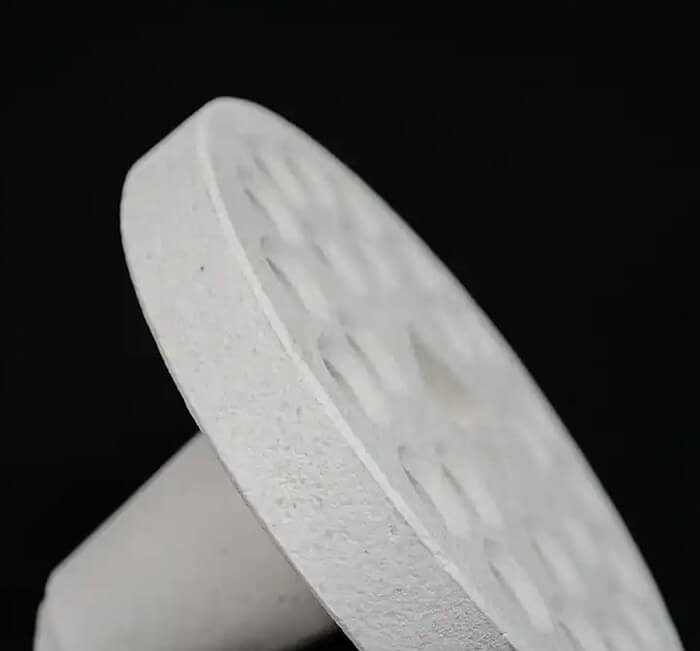
Macor
Macor, a machinable glass ceramic with a porcelain-like appearance, is white, odorless, and composed of about 55% fluor phlogopite mica and 45% borosilicate glass. This unique composition makes Macor exceptionally machinable, similar to metals in this regard. It boasts high dielectric strength, excellent physical properties, and significant electrical resistivity.
For effective machining, the use of carbide tools is advised, as they extend tool life and enhance finishes. Macor’s structure helps localize micro-fractures caused by CNC machining, thereby maintaining the integrity of the ceramic. Its wide-ranging applications span various industries, including the production of spacers, cavities, and reflectors for laser assemblies, high-voltage insulators, precision coil formers in electronics, thermal breaks in high-temperature processing equipment, and as a radiation-resistant material in the nuclear industry for reference blocks.
Glass
Glass, encompassing materials like Vycor and Pyrex, is a notable ceramic with remarkable attributes, such as excellent impact resistance, high durability, and a low thermal expansion coefficient. Its exceptional thermal shock resistance makes it ideal for various optical applications, where it can appear translucent, opalescent, or even opaque.
Graphite
Graphite, a carbon-based ceramic, varies in density based on its polymer state and is highly sought after for its exceptional chemical resistance and thermal shock properties, making it ideal for machining parts that must endure high temperatures.
This material also features high thermal resistance, low friction, self-lubrication, and excellent electrical and thermal conductivity, alongside notable resistance to neutron radiation. Machining graphite, however, can be challenging due to its abrasive nature, often causing rapid tool wear; hence, diamond-coated tooling is recommended for optimal machining results.
CNC machined graphite parts have a broad range of applications across different industries, including the production of carbon brushes for electrical motors, Magnesia carbon bricks for steel-making furnaces, automotive components like clutches, brake drums, and pads, and even as moderators in nuclear reactors due to its excellent thermal and neutron radiation resistance.
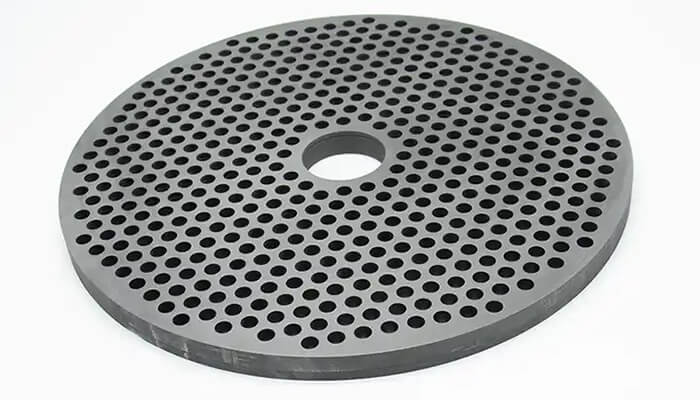
Mycalex
Mycalex, also known as Mica, stands out as a highly machinable ceramic available in four grades, each offering different temperature performance capabilities. Its superb machinability is perfect for crafting components with complex shapes and small sizes. Beyond its ease of machining, Mycalex boasts several advantageous features like moisture resistance, high-temperature dimensional stability, and excellent dielectric strength.
Thanks to its high machinability, Mycalex is well-suited for various CNC machining operations, including turning, drilling, milling, and grinding. This versatility makes it a popular choice in industries such as aerospace, defense, cryogenics, communication, and electronics. Mycalex is also ideal for producing high-vacuum components, including IC test sockets, arc chutes, barriers, and equipment for gas chromatography and mass spectrometry.
CNC Machining Operations for Ceramics
The use of CNC machining in the fabrication of ceramics allows for the creation of parts with exceptional precision and close tolerances. This technique simplifies the production process for ceramic parts featuring complex shapes and detailed designs. The following are some of the most effective CNC machining operations for crafting ceramic materials.
CNC Milling
In the CNC milling process for ceramics, a machine guided by computer commands employs a spinning cutting tool to shape a ceramic piece by removing material. This technique skillfully carves out the required form or design.
A primary benefit of utilizing CNC milling in ceramic production is the capacity to craft intricate shapes with remarkable accuracy. The precision of the computer-controlled machine ensures consistent and accurate cuts as outlined in the design specifications. Additionally, CNC milling is capable of yielding parts with a smooth surface finish, thereby reducing or eliminating the need for extra polishing or finishing procedures.
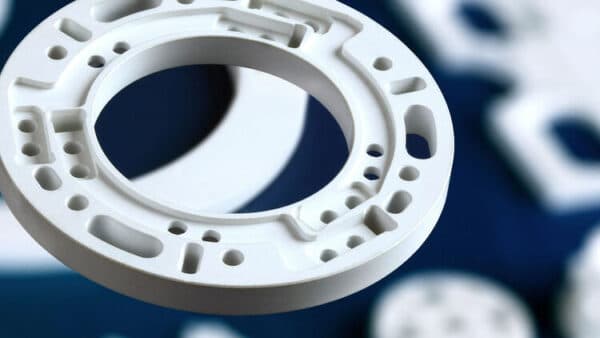
Core Drilling
Core drilling is a specialized drilling technique that extracts a cylindrical section of material from a larger block or piece. This method is employed to precisely drill holes of certain diameters in ceramic materials for various applications. These applications can include creating pathways for electrical wiring, mounting components, or establishing plumbing or ventilation systems. The process involves a CNC machine directing a rotating cutter, often a diamond-tipped drill bit, to bore the hole, with computer software ensuring the hole’s exact size and position.
Machining ceramics through core drilling presents unique challenges due to the hardness and brittleness of ceramics. To mitigate the risk of breakage, operators must meticulously manage the drill bit’s speed and frequently use coolants to minimize heat buildup during cutting. Additionally, the use of specialized cutting tools, such as diamond-tipped drill bits, is often necessary to effectively penetrate the ceramic material.
Wafer Dicing
The CNC machining process of wafer dicing is particularly effective for producing ceramic parts from materials like quartz and graphite. This process involves separating individual dice from a ceramic wafer, which can be accomplished through various methods such as breaking, laser cutting, mechanical sawing, or scribing. To facilitate handling, the wafer is often mounted on a film frame, while mounting on glass enhances the precision of the cuts.
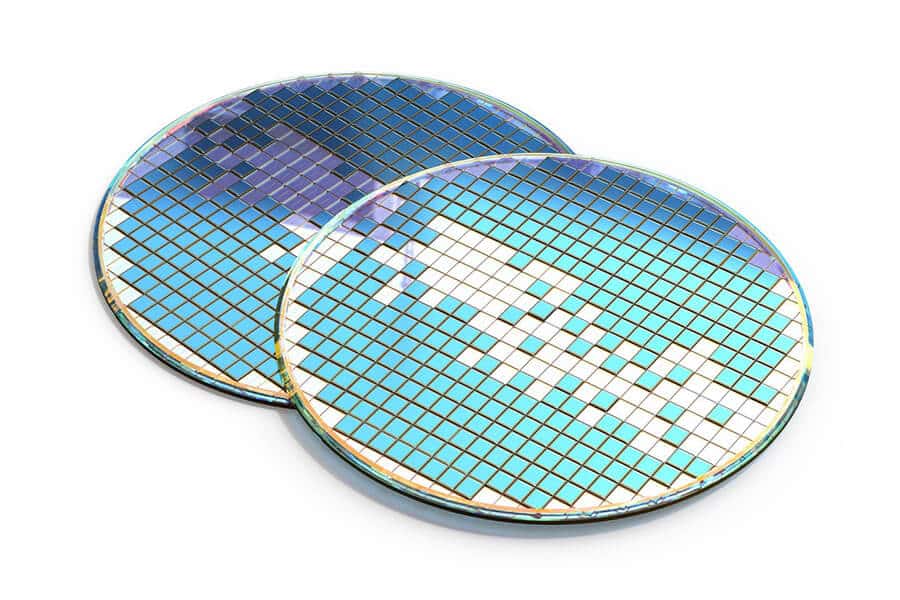
ID Slicing
ID slicing, also known as Inner Diameter slicing, is a specialized machining technique used for making repeated cuts in brittle or hard materials. This process utilizes a saw blade with a diamond-plated internal diameter and an annular design, which contributes to improved cutting accuracy and reduced kerf loss.
Fabricating ceramics using the ID slicing method is relatively straightforward, requiring minimal setup. This simplicity, along with the efficiency of the process, makes it a more cost-effective option for ceramic production.
Surface Grinding
Surface grinding is a technique where a grinding wheel is employed to eliminate material from a workpiece’s surface. This process is particularly useful in the ceramics industry for producing precise and smooth surfaces on ceramic parts.
The precision required in surface grinding ceramics is crucial, as any surface flaws can significantly impact the component’s functionality. This method is commonly utilized to achieve flat and parallel surfaces on ceramic parts, as well as to eliminate any surface imperfections or damage.
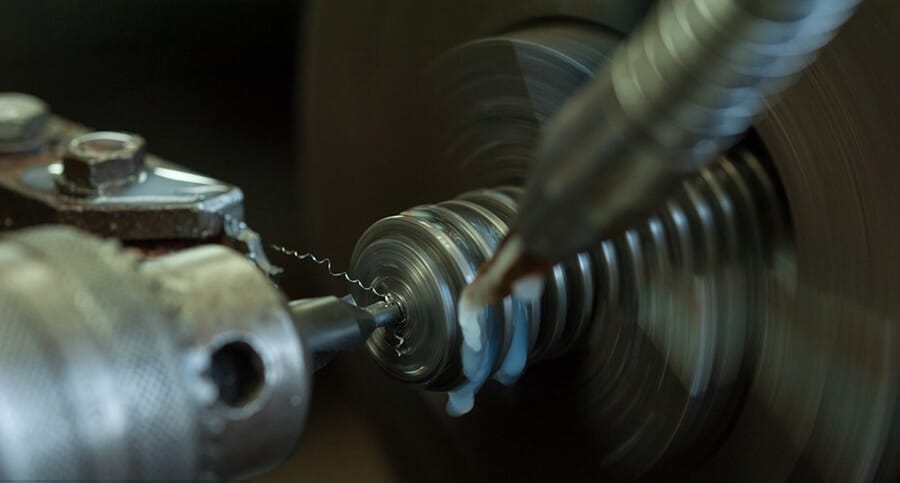
Advantages of CNC Machining in Ceramics
While there are various techniques for shaping ceramics, such as waterjet cutting, laser cutting, and kiln processing, several compelling reasons make CNC machining an advantageous method for producing ceramic components.
Versatility
Ceramic CNC machining stands out for its exceptional precision, enabling the production of complex and detailed ceramic components. The integration of CNC machinery and sophisticated software allows for meticulous control over cutting and shaping tools, ensuring the fabrication of high-quality and accurate parts that satisfy even the most stringent requirements.
Cost-Effectiveness
When compared to other fabrication methods like laser cutting and waterjet cutting, CNC machining of ceramics emerges as a more cost-effective option. This cost efficiency stems from the reduced number of errors and a higher production rate achieved with CNC machining compared to laser cutting. Additionally, the overall expenses associated with CNC machining for ceramics tend to be significantly lower than those for laser cutting.
Scalability
The process of machining ceramics with CNC is highly scalable. This means that it allows for the adjustment of production volumes based on market demand, either increasing or decreasing the quantity of ceramic parts manufactured. Such scalability aids in minimizing material waste, as products are made according to demand.
High Precision in Cutting and Shaping
The process of CNC machining offers exceptional control and precision. This aspect is particularly crucial for machining ceramics, considering their inherent rigidity and brittleness.
Capability to Make Complex Geometries
CNC machining of ceramics is capable of creating intricate shapes that might be challenging or even unfeasible to produce using alternative techniques.
Tight Tolerances
Ceramic CNC machining is renowned for its ability to achieve very tight tolerances, which are often essential for numerous applications.
Disadvantages of Using Ceramics in CNC Machining
Ceramic CNC machining, though beneficial in certain aspects, also has its share of drawbacks. Here are some of the disadvantages associated with ceramic CNC machining.
Brittle Nature
Ceramics are recognized for their strength and hardness, yet they are notably brittle due to their crystalline structure, which lacks the flexibility found in metals. As a result, they are prone to cracking and chipping under stress.
Vulnerability to Damage
During the CNC machining process, ceramic materials are at a heightened risk of damage. The machining process can exacerbate existing stresses, making it difficult to attain the intended design. This issue often results in the materials suffering from cracks, chips, or breaks throughout the machining process.
Difficulty in Machining
Machining ceramics poses a significant challenge due to their extreme hardness, often surpassing the hardness of the cutting tools used in CNC machining. This discrepancy can cause substantial wear and damage to the tools, resulting in higher tooling expenses, extended machining durations, and a potential decrease in the quality of the finished parts.
Extended Production Time
Ceramic CNC machining is often characterized by extended production times. The inherent hardness and brittleness of ceramics make the machining process more complex and time-consuming than working with metals. Additionally, the high level of precision required for ceramic machining necessitates the use of specialized tools and equipment, which can further delay the completion of projects.
Ceramic CNC Machining Process
In the modern world of precision-oriented industries, Ceramic CNC machining stands out as a top choice. This process utilizes advanced computer technology to fabricate detailed, high-accuracy components, especially from the complex ceramic materials employed in CNC ceramic material operations.
Component Design Stage
At the beginning of the CNC ceramic component production process, design plays a crucial role. Engineers employ CAD software to precisely create a detailed plan of the desired ceramic component.
This design is pivotal as it forms the basis for the entire machining operation. It is transformed into a CNC program, which acts as the directive for the CNC machine. This program enables the machine to execute high-precision ceramic machining tailored to the specifications set by the manufacturer.
Choosing and Preparing the Material
The choice of appropriate ceramic material is a critical aspect of CNC ceramic machining, dependent on the specific needs of the intended application. Considerations such as the material’s strength, thermal conductivity, and durability are key during this selection phase.
After selecting the suitable ceramic material, careful preparation is essential before its introduction to the CNC machine. This preparation stage involves verifying that the material is devoid of impurities, contaminants, or any anomalies that might affect the accuracy of the machining process.
Machining
This stage is central to Ceramic CNC machining. Guided by the CNC program developed earlier, the CNC machine takes center stage. It skillfully converts the ceramic from its raw form into a component shaped with exactness.
The hallmark of this process is its remarkable precision. The CNC machine operates with minimal margin for error, delivering uniform outcomes. It adeptly handles complex geometries and the production of multiple parts, maintaining impeccable accuracy throughout.
Additional Finishing
After the machining concludes, the process isn’t over yet. Post-processing plays an essential role in guaranteeing that the ceramic components conform to the utmost standards of quality and precision. This stage includes a detailed cleaning to eliminate any residual material left from the machining.
At Runsom Precision, each piece undergoes a rigorous inspection process to detect and correct any flaws. Additional finishing work is performed as necessary to align the components with the specific requirements of their intended use. This thorough post-processing phase ensures that the ceramic components stand as exemplars of accuracy and excellence.
The meticulous nature of this CNC ceramic component production approach guarantees that the final products meet the highest standards of quality, making them suitable for a wide range of industrial applications.
Considerations for Designing Ceramics for CNC Machining
When planning the design of ceramics for CNC machining, several factors must be taken into account. Ceramics are known for their strength, durability, and versatility, making them suitable for diverse applications. Their widespread use is due to these properties, but designers need to be aware of specific considerations before proceeding with ceramic machining.
Choosing the right machining method is crucial and should be tailored to the specific type of ceramic. Different ceramics respond differently to various machining techniques. For instance, Mullite is compatible with laser cutting, whereas Zirconia, a more fragile ceramic, requires abrasive methods for cutting and shaping. Understanding the properties of the ceramic material is key to selecting the appropriate machining tool.
In any manufacturing process, creating a prototype is a critical step, and this is particularly true for ceramic parts with complex designs. Prototyping allows for thorough testing and evaluation before mass production. It provides an opportunity to refine the design and make necessary modifications based on the prototype’s performance.
Additional tips for effective ceramic design:
- Employ a modular approach in your design.
- Avoid clear sharp and elongated edges.
- Favor circular designs over oval shapes.
- Be mindful that sharp edges and corners can heighten the likelihood of breakage.
- Consider using corner pockets as a viable alternative to sharp corners, especially if avoiding rounded edges.
- In designs incorporating holes and slots, ensure they are adequately spaced to avoid crowding.
- Opt for simpler wall designs and shapes rather than complex ones.
- Avoid abrupt transitions in cross-sectional areas.
- Transform tensile stress into compressive stress, enhancing the ceramic material’s capacity to endure stress without cracking.
Guidelines for Effective CNC Ceramic Machining
Should you encounter any of the aforementioned challenges or other difficulties in CNC ceramic machining, the following tips may prove beneficial for implementation:
Choosing the Right Material
The foundation of effective CNC ceramics machining lies in the selection of the appropriate material. It’s important to weigh aspects like hardness, resistance to wear, thermal stability, and electrical insulation, tailored to your specific needs. Every ceramic material possesses distinct characteristics, and picking the one that aligns best with your requirements is key to achieving superior performance and longevity.
Choosing the Right Tools
For CNC machining of ceramics, the choice of cutting tools is vital. Diamond or CBN (Cubic Boron Nitride) tools are often preferred due to their ability to withstand the hardness of ceramics and resist wear. By choosing the right tools, you can reduce wear and enhance the efficiency of the ceramic CNC machining process.
Setting the Right Machining Parameters
To attain precision and mitigate potential issues in CNC ceramics machining, it’s crucial to fine-tune machining parameters. Carefully adjusting aspects like cutting speed, feed rate, and depth of cut can help mitigate the effects of material brittleness, tool wear, and excessive heat. Regularly monitoring and tweaking these parameters is key to a successful CNC machining operation for ceramics.
Implementing Effective Cooling and Lubrication
In the CNC machining of ceramics, proper cooling, and lubrication play a vital role. These practices are crucial for managing heat generation and preventing thermal distortion of the material. They also contribute to prolonging the life of the tools and maintaining the quality of the ceramic components during fabrication. Following these guidelines ensures a seamless and efficient process in CNC ceramic machining.
Challenges and Solutions in Ceramic CNC Machining
In this part, we’ll explore various obstacles encountered in ceramic machining and provide potential solutions to enhance the process.
Challenges
1. Brittleness of Ceramics
One of the primary difficulties in ceramic machining is the inherent brittleness of ceramics. This property makes them susceptible to breaking or cracking, especially under sudden forces, vibrations, or any flaws that might occur during the machining process. Such breakage can lead to increased waste, higher costs, and delays in production.
2. Challenges with Complex Designs
Shaping intricate designs is a considerable challenge in CNC machining for ceramics, mainly due to the ceramic material’s high hardness. Complex designs often necessitate the use of smaller tools or highly precise machining techniques. This can create challenges in maintaining the integrity of delicate features or achieving detailed aspects of the design.
3. Wear and Tear of Tools
In the CNC machining of ceramics, tool wear presents a major issue. Due to the hardness and abrasive nature of ceramics, they tend to cause significant wear on cutting tools, leading to their quick deterioration during the machining process. This issue not only escalates costs but also diminishes the accuracy and quality of the final product, along with generating more scrap material.
Solutions
1. Managing Ceramic Brittleness
To counteract the brittleness of ceramics in CNC machining, various methods have been implemented. One method is enhancing the quality of the ceramic materials. This is done by reducing defects in the raw materials, employing advanced sintering techniques to lower porosity, and carefully managing the additives’ composition to increase toughness.
Another approach focuses on refining the CNC machining process to lessen the chances of cracking or chipping. This includes identifying the optimal tool path and speed for the specific ceramic material, along with vigilant monitoring of the cutting forces in operation. To reduce vibrations and ensure stability during cutting, machine tools can be outfitted with adaptive control systems or other technologies to detect and counteract vibration.
Addressing ceramic brittleness also involves thoughtful tool design. Tools that are designed appropriately can lessen the occurrence of surface cracks or chips and can help reduce the stress exerted during cutting. Diamond tools are often chosen for ceramic CNC machining because of their low friction and high resistance to wear, though other materials like cubic boron nitride (CBN) can also yield impressive results.
In summary, the significant brittleness challenge posed by ceramics in CNC machining can be addressed through several strategies. These include improving the ceramic materials’ quality, fine-tuning the CNC machining process, and using well-designed tools. It’s crucial to collaborate with experienced and knowledgeable ceramic CNC experts like Runsom Precision who specialize in the precision machining of ceramics.
2. Addressing Challenges in Shaping Complex Designs
To tackle the challenge of shaping complex designs in ceramic CNC machining, various strategies are employed. One highly effective method is the use of CAD software to conceptualize the part and optimize the machining path. This software generates an accurate 3D model that facilitates the creation of a comprehensive CNC machining plan to guide the entire process.
Another crucial strategy is selecting the most appropriate cutting tool for the task. Diamond tooling, for instance, is excellent for crafting very small, precise features while maintaining a smooth finish on the ceramic material, all without generating excessive heat. Some CNC machines offer versatility in spindle types, including cooling, heating, or ultrasonic spindles, which aid in producing intricate shapes.
Additionally, utilizing multi-axis CNC machines offers a significant advantage. These machines can rotate and adjust the workpiece with ease, enabling the machining of complex shapes from various angles with high precision. Multi-axis CNC machines also contribute to better surface finishes and overall part accuracy, minimizing the need for extensive post-processing.
In summary, the complexities involved in shaping intricate designs in ceramic CNC machining can be effectively managed through a blend of CAD software, judicious tool selection, advanced multi-axis machines, and other targeted machining techniques. These methods enable manufacturers to produce complex ceramic parts with high precision, tight tolerances, and detailed features, ensuring that the final products align with the client’s exact specifications.
3. Addressing Tool Wear
Several measures have been devised to combat the issue of tool wear in CNC machining. A widely adopted solution is the use of superior quality cutting tools that are specifically made for working with ceramics. These tools are more resilient to the abrasive nature of ceramics, offering enhanced wear resistance, which translates to a longer lifespan for the tools and ultimately, cost savings.
Another effective method is the application of protective coatings to the cutting tools. Coatings such as diamond-like carbon (DLC) can provide a hard, low-friction surface on the cutter, which helps in resisting wear and extends the durability of tools.
Proper cooling or lubrication plays a vital role in minimizing tool wear during CNC machining of ceramics. Using a high-temperature coolant or lubricant helps prevent adhesion between the tool and the workpiece, thereby safeguarding the cutting tool. Additionally, adjusting the cutting conditions, such as the speed and feed rate, can alleviate other stresses on the tool, further reducing wear.
To sum up, the challenge of tool wear in CNC ceramic machining can be effectively addressed by optimizing cutting conditions, choosing high-quality tools designed for ceramic materials, applying protective coatings, and ensuring adequate cooling and lubrication.
Applications of CNC Ceramic Machining
CNC ceramic machining is versatile and finds its use across various industries, ranging from the manufacture of common household items to the large-scale production of decorative objects. Among its numerous applications, the most prominent ones include the electronics, industrial, medical, and automotive sectors.
Medical
CNC machined ceramics are extensively used in the medical sector. The strength, biocompatibility, and corrosion resistance of ceramic materials make them perfect for medical implants. In dental medicine, prosthetics like crowns, bridges, and implants are frequently crafted using CNC machining from ceramics. Zirconia, a specific type of ceramic, is especially popular in dentistry for creating high-quality dental implants.
Additionally, the capability of ceramics to be CNC machined into intricate shapes is crucial for fabricating custom implants tailored to individual patients. This adaptability allows for precise and personalized medical solutions.
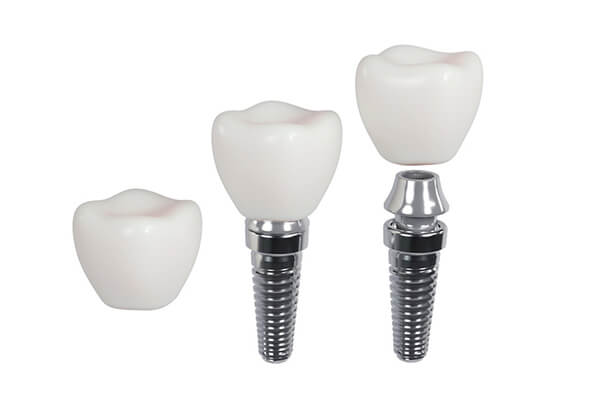
Electronic
In the electronic and electrical industries, CNC machining of ceramics is a popular choice for creating parts that boast high dielectric properties, along with being durable, heat-resistant, and wear-resistant. The remarkable heat resistance of ceramics renders them perfect for fabricating components that must endure extreme temperatures and challenging environments.
Various components in the electrical and electronic sectors are produced using CNC machined ceramics. These include heat sinks for circuit boards, vacuum interrupters, substrates, insulators, and components for microwaves. Ceramics like macor, quartz, or aluminum nitride are commonly utilized in the semiconductor manufacturing process due to their suitable properties.
Industrial
Ceramics find a broad range of use in industrial applications. These materials are not only suitable for large, smooth structures or pillars but excel in crafting smaller, intricate industrial parts that demand high precision.
Owing to their exceptional wear resistance, ceramics are particularly advantageous for manufacturing parts designed for longevity in active industrial settings. The varieties of ceramics employed in industrial contexts are diverse, including materials such as mycalex, mullite, and quartz, among others.
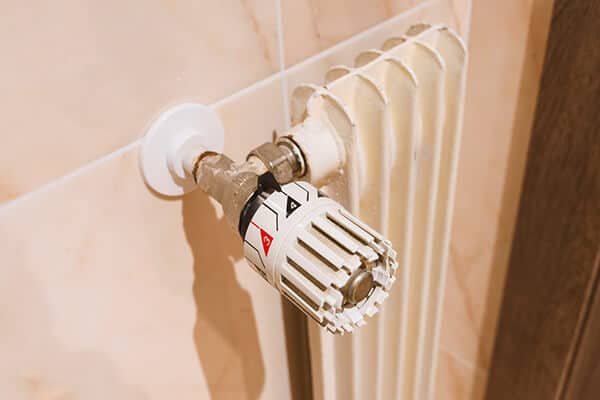
Automotive
The automotive sector has been utilizing CNC machined ceramics for their notable advantages. Among the most prevalent ceramic parts in this industry are brake components. Ceramic brake pads, in particular, offer superior resistance to wear and tear, outlasting traditional brake pads.
Furthermore, ceramic brake pads excel in dispersing the heat produced during braking. This enhances both performance and safety. In addition to brake components, other automotive parts such as spark plugs, valves, gears, and engine blocks can also be manufactured using CNC ceramics. Materials like aluminum nitride or boron nitride are often selected for these applications.
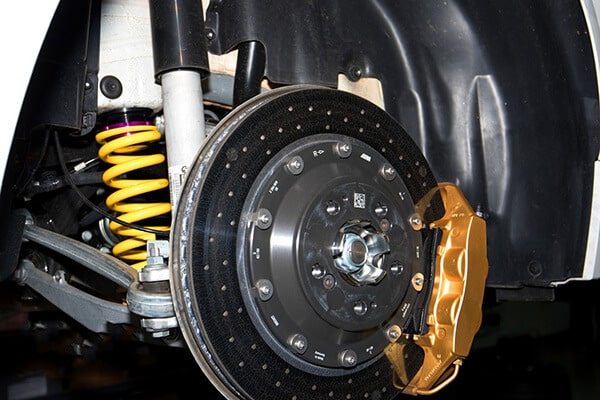
Conclusion
CNC machining excels in the mass production of a wide array of products and components that demand high precision and strict compliance with design specifications. Nonetheless, the inherent characteristics of ceramics, such as brittleness and limited tensile strength, present unique challenges in this process.
Designing parts requires meticulous attention to detail to minimize the risk of breakage. Specialized tools, capable of handling the hardness, strength, and toughness of ceramics, are essential for their machining. Crucially, an understanding of the various types of ceramics is needed to select the most appropriate material for your specific products or components.
Custom Ceramic CNC Machining Service at Runsom Precision
Runsom Precision stands as a trusted manufacturing entity, boasting extensive experience in CNC machining of diverse materials, notably ceramics. Our commitment to state-of-the-art CNC machining methods guarantees superior precision, accuracy, and productivity in the fabrication of ceramic and other high-grade materials. We have successfully executed many custom ceramic development projects for clients globally. For crafting a CNC machined ceramics prototype or final product, simply submit your design on our website and receive an instant quote on our Ceramic CNC Machining Services today.
Other Articles You May Be Interested in:

